

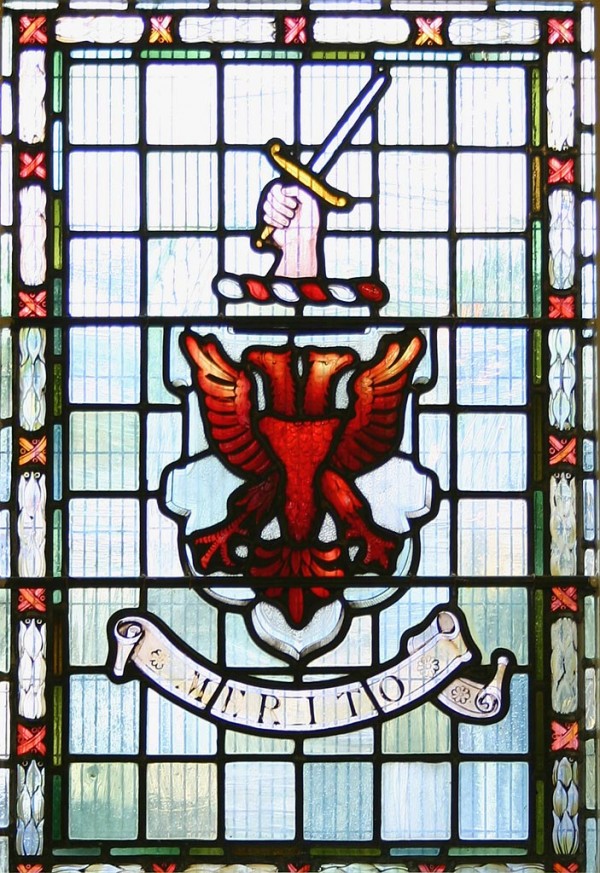
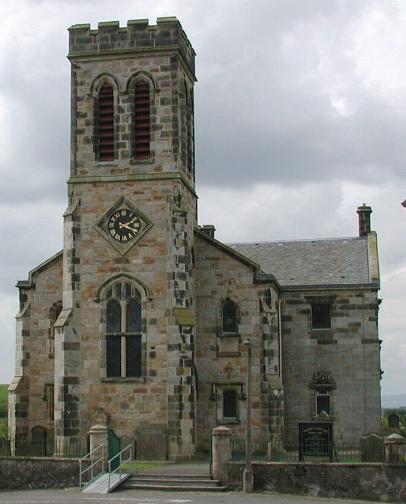 The
feudal system set the scene fo
The
feudal system set the scene for
the establishment of the Scottish church (then Roman Catholic) and a church was
built at the foot of Dunlop Hill at the point where the three brooks : the
Templehouse Burn, the Black Burn, and the Glazert met. ( Three was a sacred
number in the Druidic Philosophy, also the point where streams met, and
springs.....again we see an example of the Roman Church overlaying their own
holy sites over existing Celtic holy sites for the ease of conversion.)
The first building was erected as early as 1150. It is mentioned in the book "Cunninghame" by Pont. The building had little architectural distinction, being no more than a small house, in the mode of Davidic churches.
It was made a Vicarage of Kilwinning as early as the Twelfth century. The Church was demolished and rebuilt slightly bigger in 1642. It was again rebuilt larger in 1835.
Kirkyard...click
on for large photo by Deane Gemmell
 It is said that the Dunlop aisle was part of the 1642 church, but there is some
dispute. There is a plaque in the Vicar's room that states that the Vicaria of
Dounlap has been recorded since 1275, and the Names of all vicars are listed
from 1468's John Restoun through 1563's Hans Hamilton to today's Maureen Duncan.
It is said that the Dunlop aisle was part of the 1642 church, but there is some
dispute. There is a plaque in the Vicar's room that states that the Vicaria of
Dounlap has been recorded since 1275, and the Names of all vicars are listed
from 1468's John Restoun through 1563's Hans Hamilton to today's Maureen Duncan.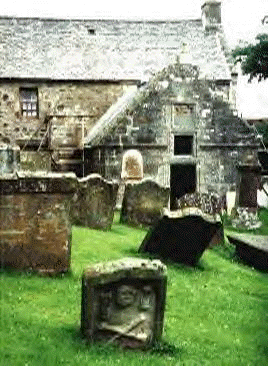
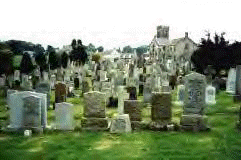 The
current Kirk is well known for its seventeen stained glass windows, one of which
you can see on the "arms" page on this website. The Church is of rectangular
design lying east and west, crowned by a massive tower, sixty feet high, and
seats 730. The windows were all donated by families connected to Dunlop. A
churchyard containing many memorials, including one mausoleum in memory of Hans
Hamilton dating early 17th century and many other early stones, straddles the
Kirk.
The
current Kirk is well known for its seventeen stained glass windows, one of which
you can see on the "arms" page on this website. The Church is of rectangular
design lying east and west, crowned by a massive tower, sixty feet high, and
seats 730. The windows were all donated by families connected to Dunlop. A
churchyard containing many memorials, including one mausoleum in memory of Hans
Hamilton dating early 17th century and many other early stones, straddles the
Kirk.
 Martin Galloway
Martin Galloway
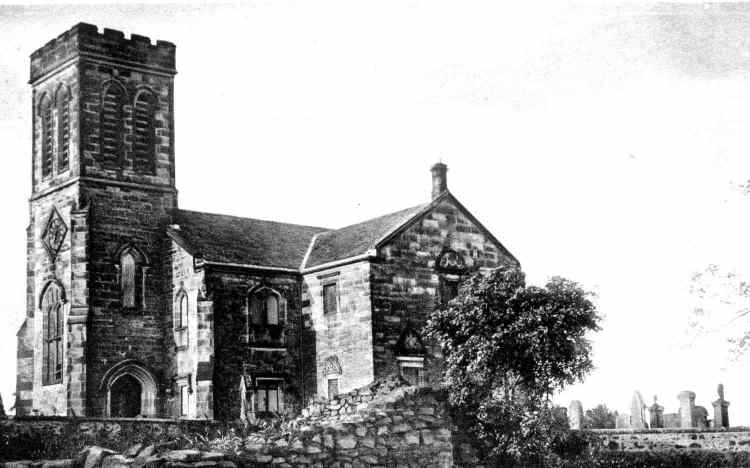
Biased, would be the best description for my love
of the Dunlop Parish Church. Having lived in the village for nearly 30 years,
the Kirk was an obvious target for my photography hobby. Since 1972 starting
with a Zenith B 35mm camera, I have photographed the stone beast hundreds of
times, day and night and in every season imaginable.
The beauty of the Church and it’s surroundings
have most definitely contributed to it’s longevity within the ranks of the
Church of Scotland. Built in 1835, replacing a smaller vestige, the first
parishioners walked through the doors a few weeks before Christmas 1835.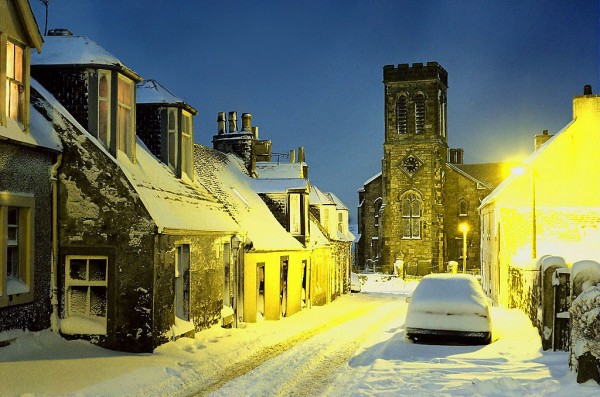
The main floor plan faces an East South East /
West North West direction, with a smaller gable forming the buildings T-shape
facing North North East. This North facing gable is all that remains of the
original Kirk pre 1835. Little is known about the place of worship
preceding the construction of the one that sits here today. What is certain is
that there was a semblance of interest in preserving what was salvageable from
the past. A date of 1641 on the gable is testament to the rich history of what
was here before.
The Church graveyard is the only burial site in the whole Parish. Suggesting that later Kirks simply replaced previous ones, all sharing their roots from the very first in the Parish many hundreds of years ago.
The north gable was originally built by James Dunlop of Dunlop (15th) His initials “I. D.” are still visible today etched in triangular stone insets above the window to the right of the door. On the left the letters “E.C.” are visible, this being James’ wife Elizabeth Cunninghame.
The present building is not entirely typical of 19th Century Churches. A beautiful tower stands proudly to the East and is unusually high for the overall design. At 60.5 feet the tower houses a single bell, adorned with no less than four pairs of Gothic arched slats. It is topped by an embattled parapet accentuating it’s nobility. In 1987 I was blessed with the opportunity of walking up onto the tower and the 360 degree view is simply stunning.
The entire Church houses no less than 21 beautiful stained glass windows, but they were not all here from the beginning. Generosity, a love of the Church, parishioners that possessed the financial means and a heavenly desire to contribute, have embellished the Dunlop Church as we see it today.
One such admirable gift was from Thomas Douglas Cunninghame Graham during 1882. Mr Graham provided a set of large stained glass windows that are to be seen in all their splendour on the South wall of the Kirk. See photo top of page. Mr Graham was indeed a great friend to the Dunlop Church.
Two years after donating the windows, in 1884, Thomas once again provided the Lions share of funding for extensive renovations to the interior. Virtually all of the pews and the choir stance were totally remodelled. The pulpit was restyled to compliment the design of the aisle windows. An octagonal baptismal font was added and sits proudly in front of the pews to this day.
| The lower half of
the Dunlop Aisle during this time was fitted with new stained glass windows.
They depict the armorial bearings of Dunlop of Dunlop (East side), Dunlop
Douglas of Dunlop (West side) and Cunninghame Graham of Dunlop (North side).
The brighter, renovated and more colourful Church opened it’s doors and it’s arms on Sunday 31st Aug. 1884… but on a sad note. The very man who had so lovingly contributed to the stature of the Church ’s beauty, Thomas Douglas Cunninghame Graham, died on the Wednesday 27th August, four days before. Ironically Mr Graham passed on the evening that the work was completed. As if in some divine way he knew that his own personal quest had been fulfilled. Everyone passing through the Church gates these days have a lot to thank Mr Graham for. Lest we forget others like him who have ultimately made the Kirk a better more harmonious place to enjoy, thanks to their generosity. |
ANCHOR LINE STEAMSHIP CO.Did you know that the Dunlop Church has a connection with the Anchor Line steamship Co? Indeed it does. If you look way up at the West wall there you will see two tall windows. They depict Adam on the left and Jesus on the right. The windows were donated by Francis Henderson, one of the brothers who owned the Glasgow based Anchor Line Steamship Co. Francis was a regular visitor to the Church whilst living at Dunlop House. A second window was installed in 1934 in the north wall of the Vestry Gallery in memory of Francis and his generosity to the Church. Kindly donated by his widow Mrs Henderson and three children. The window pair depict St Nicholas on the left and St Christopher on the right. It is interesting to note that Saint Nicholas is holding a wooden ship. This window also contains two anchors, but you have to look closely for the second one. This, an obvious yet tasteful reference to the Anchor Line Co. Mrs Henderson travelled over 450 miles from the south of England to Dunlop to unveil the window. Accompanied by her son, then Lieutenant Colonel Sir Vivian Henderson MP., Lady Henderson and her daughter. It was a fitting tribute to yet another of the Dunlop Church ’s endearing members. The Henderson windows are beautiful and we are lucky to have them. The plethora of windows certainly provide a good deal of light on a bright day, but gas lamps were on their way out. Electricity arrived in 1924 with new lights and a further renovation project. This time the congregation paid for the work. 1924 also ushered in a new era in administration for the Church. It was duly handed over to the General Trustees, furthering the strengths of available funding. During a visit in May 2005 I photographed every window in the Dunlop Church with a high resolution digital camera. My thanks to Mr. John Gibson the Church Officer for displaying such divine patience whilst I climbed over pews with my tripod. You can see the images and read detailed descriptions by clicking on the link at the top of the page. |
.Photo: Hans Hamilton's Tomb .exterior. (C) Jill Stevenson. |
You'll never see it if you are just driving past, but there is a wee surprise for historians at the back of the Clandeboye Hall. (the little building at the front left of the Kirk) In memory of Hans Hamilton, the very first Protestant minister of Dunlop, there is an unassuming looking mausoleum holding the graves of the minister and his wife.
Standing about 12 feet by 10 feet it is constructed of the same type of stone as the Kirk itself, ashlar. It was built by the Hamiltons son, James Viscount Clandeboye. The tomb is very difficult to view due to the lack of light falling into it. Inside is a marble recess with a curved roof. Statues of a man and woman depict Hans and his wife, both kneeling towards each other with hands raised as if in prayer.
The entire recess holding the tomb appears to be behind curtains, skillfully carved in stone. Overall it is an interesting piece but is a photographers nightmare. The gauge of the steel mesh door wouldn't allow a finger to pass through let alone a lens. So for now - no piccies of the interior. Inside there are a number of inscriptions on most of the walls and the tomb itself. Below is a transcript of the words as kept in historical records at the Dick Institute Kilmarnock.
HEIR LYES THE BODIES OF HANIS HAMILTON, SONNE OF ARCHIBALD HAMILTON OF RAPLOCH, SERVANT TO KING IAMES THE FIFT, & OF IANET DENHAM HIS WIFE, DAVGHTER OF IAMES DENHAM, LAIRD OF WEST-SHEILDE, THEY LIVED MARYED TOGETHER 45 YEERES, DVRING WHICH TYME THE SAID HANS SERVED THE CVRE AT THIS CHVRCH. THEY WERE MVCH BELOVED OF ALL THAT KNEW THEM, & ESPECIALLY OF THE PARISHIONERS. THEY HAD SIX SONNES, IAMES, ARCHIBALD, GAVIN, IOHN, WILLIAM & PATRICK & ON DAVGHTER, IEANE, MARYED TO WILLIAM MVIRE OF GLANDERS TOVNE.
THE DVST OF TWO LIVES IN THIS ARTE-FVLL FRAME, WHOSE BVRTH THEM HONOR'D. FROM AN HONORED NAME, A PAINEFVLL PASTOR, AND HIS SPOTLES WIFE, WHOSE DEVOVT STATVES EMBLEME HERE THERE LIFE BLEST WITH THE HEIGHT OF FAVORS FROM ABOVE, BLOOD, GRACE, A BLEST MEMORIAL, ALL MEN'S LOVE. A FRVITFVLL OFSPRINGE ON WHOM THE LORD HATH FIXT FORTVNES WITH VIRTVE, AND WITH HONOR MIXT, THEN LIVE THESE DEAD ABOVE IN ENDLES IOYES, HEERE IN THEIR SEID AND NOBLE CLANDEBOYES IN WHOM (GRAVNT SOE, O HEAVENS) THEIR HONORED NAME MAY NEVER DIE, BVT IN DEATH OF FAME.
ROM. 8 CH. VER. 18 - THE
AFFLICTIONS OF THIS LIFE ARE NOT WORTHIE OF THE GLORY WHICH SHAL BEE SHEWED VNTO
VS.
PROV. 31 CH. VER. 10 & 30 - THE PRICE OF A VERTVOVS WOMAN IS FAR ABOVE PEARLES.
A WOMAN THAT FEARETH THE LORD SHAL BEE PRAISED.
DAN. 12 CH. VER. 3 - THEY THAT TVRN MANY TO RIGHTEOVSNES SHALL SHINE AS THE
STARRS FOR EVER AND EVER.
THIS MORTALL MVST PVT ON IMMORTALLITY, 1 COR. 15 & 53.
HEIR . LYIS . HANES . HAMMILTOVN . VICAR . OF . DVNLOPE . QVHA . DECEISIT . YE .
30 . OF . MAH . 1608 . OF . YE . AIGE . OF . 72 . ZEIRS . AND . OF . IONET .
DENHAME . HIS . SPOVS.
HEIR . RESTIS . THE . BODIE . OF . IONET . MAXWELL . SPOVS . TO . MAISTER . HEW
. EGLINTOVN . MINISTER . OF . DVNLOP . QVHA . DECEISIT . THE . 30 . OF . IANVAR
. 1628 . IVSTVS . FIDE . VIVIT.
During my visit in May of 2005, I was rather shocked when I looked through the gate of the tomb. To my dismay many parts of the interior were missing. Thankfully this was not a result of vandalism but the problems are equally as delicate. I spoke with several of the local historians and there is much consternation surrounding the "ongoing" and "renovation" of Hans Hamiltons Tomb.
For years there was scaffolding surrounding the rear of the structure, not only an eyesore but certainly an obvious sign that nothing was being done. Now let's not become complacent here about what looks like a grubby little tomb. This is a rare piece of early 17th Century architecture and we owe it to the ongoing history of Dunlop to keep it here. Whether the difficulties are financial or administrative, something has to be done. If not we shall wake up one morning and find the roof has collapsed in on itself.
Some entity is responsible for it, behind every organization is a human making a decision. Hans Hamilton's Tomb needs that person or persons to be accountable for their decision making. Whatever system is in place right now... it's not working. It would be a tragedy of historical proportions if the Tomb was lost in a sea of bureaucracy.
Hans Hamilton's Tomb needs love and attention and the parts that I saw missing need to be returned to Dunlop where they belong.
Photo: Rev. James Currie hosting the Gala Day at Dunlop playing fields. 1976. |
Photo: Rev. James Currie where he felt most at peace, at the Pulpit in front of large audiences, serving the Lord. |
Rangers, Graeme Souness and the Trophy Room mean anything to you? Turning yet another page in the interesting history of the Dunlop Parish Church, the arrival of the Rev. James Currie certainly shook the congregation upside down.
Shipped south from Pollok, Dunlop Church was seen as a place for the Rev. James to slow down and rest. A heart attack had brought James to the smaller greener pastures of Dunlop, but rest was something that James Currie never did. “You gotta get on” Jimmy would say, and with a swish of his black robe an ever smiling face and those upturned bushy eyebrows… off he would go wherever he was beckoned.
Many disliked the Reverend James Currie for the unorthodox way he served the Lord. Many more…. many many more… loved him. Regardless of what side of the Bible you prefer to stand on, one cannot shy away from his magnetism and hard work. Humour was an alien concept in the teachings of the Church. Telling stories and laughter was important to Jimmy, it was in his blood. This new approach to spreading the word of the Lord was indicative of the Currie years. It was also one that brought much heartache upon him and his wife Peggy. Forever at odds with the stale methods expected of him by his superiors, James was often his own worst enemy.
Crossing parishional borders was a delicate practice frowned upon by many. James Currie viewed himself a servant of the Lord – without boundaries. He would often travel in the middle of the night from the Manse Dunlop to Edinburgh, Dundee and beyond. James travelled tens of thousands of miles in a year rivaling any truck driver. All in his quest to be where he was asked to serve the people.
Soon James was on the radio, on the television in the newspapers. He brought celebrities to Dunlop, Moira Anderson to name but one. He put Dunlop village on the map. His fervent support for the Rangers Football Club brought him many friends… and just as many enemies. This public “in your face” approach by the Rev. James Currie was what separated the cloth from mediocrity.
The trips to the Holy Land ushered in a new long-distance era in the Currie years. During this time many of the local Dunlop parishioners felt abandoned, left forgotton whilst the Rev. James was “gallivanting all ower the World”. Jimmy never looked like he was at peace and if you spent a few hours with the man you would understand that meaning. He was a veritable tornado, surrounded by a million bits of paper promising appearances. Writing cards whilst talking on the phone, watching TV listening to the radio and still making you feel you were the centre of his attentions. In between there somewhere he would also find time to eat.
As quickly as the new found attentions on this small community began… it ended. On a cool damp evening on April 18th 1987 after a day on the farm in Arran… Rev. James Currie finally succumbed to another heart attack. Jimmy died in the Laigh Manse, a few hundred yards from the very Church that would host his goodbye.
The last entry in Jimmy’s diary found by his bedside…. “What a glorious day”.
Graeme Souness, then Captain of Rangers Football team was one of many celebrities who attended the funeral at Dunlop Parish Church. Over 1100 people packed the Kirk and grounds. Speakers were set up outside such was the magnitude of attendance. At the end of the day it was the people who Jimmy lived to serve…. that came in their hundreds to pay their last respects. In life all we can ever hope for … is to be remembered. The Rev. James Currie and his tenure at Dunlop Parish Church - will most definitely be remembered.
“You gotta get on”…
Photo: The single bell in the Dunlop Kirk belfry which has been heard as far away as Uplawmoor on a windy day. A viewing platform was built around the bell during the 2000 renovations. |
Photo: Interior Dunlop Kirk showing the pulpit and upper deck. May 2005. |
During a brief visit to the village in August of 2000 I noticed the stone being much lighter than usual. Also at this time the bell vents were a horrifying reddish brown colour. The word renovations was mentioned at one point, but I never investigated any further. From a layman's vantage point it looked like the Kirk had a its coat washed and a really bad paint job on the tower.
It would be 5 years before I realized the extent of the 2000 renovations. An incredible 300,000 pounds sterling and many months of painstaking work went into literally gutting the Kirk right back to the bare stone. The exterior was totally re pointed and sandblasted. Every one of the beautiful stained glass windows was removed, cleaned and replaced. The outside protective skin was removed and reframed. The interior was stripped to the bare walls and literally built back up from scratch.
Everything was painted and re-varnished and today the Kirk looks as good as the day she was built in 1835. A wrap around platform was built inside the bell tower much to my fascination. Now you can walk all the way around the bell inside the tower. Unfortunately I was not able to go up the tower during 2005, but can attest to the dangerous and precarious trip up the fragile wooden stairs that I made in 1987. All in all it was a tremendous feat of renovating skill and not at all what I had envisioned 5 years previous.
Another stained glass window was installed at this time, appropriately named the Millennium window. It can be viewed with some degree of difficulty from the stairwell leading up to the upper level of the Dunlop Aisle. There is an inscription on the stone on the North East bell tower support, indicating the renovations in the year 2000. I still think the colour of the bell vents is horribly garish and after 5 years, in 2005, the weather has at least taken some of the scream out of it.
The Dunlop Parish Church has certainly had an interesting history. Sitting at the bottom of the road at the Kirk foot, it's impossible to miss. Looking down the street the low roofs of the houses funnel your eyes right into the front gates. At night the sight is even more evangelical. A beautiful stained glass window beckons all those who travel down the street with colourful brilliance. Over a 30 year span I have personally sketched the Kirk, painted it in oils, photographed it and here I am now writing about it.
It's a beautiful building steeped in history. It's well worth a look whether you are from around the corner, or around the World.
Martin J. Galloway
